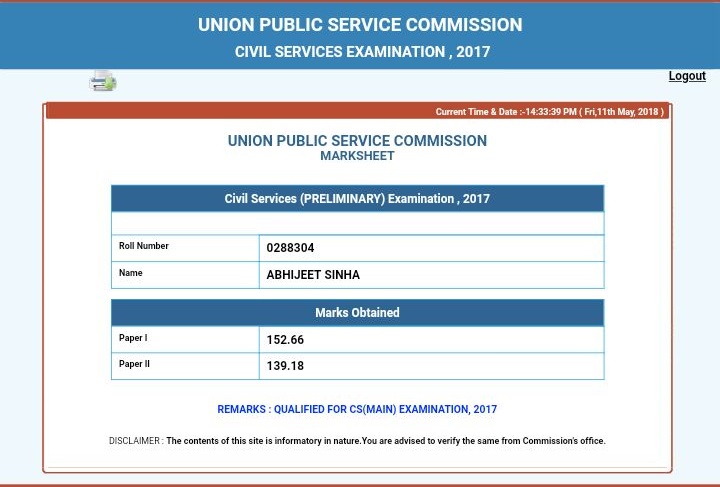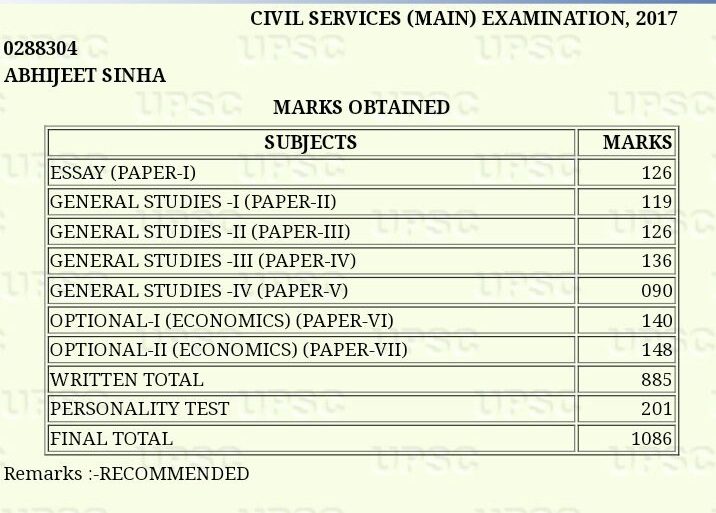IASbaba's Toppers
Hello everyone,
I am Abhijeet Sinha. I have secured 19th Rank in Civil Services Exam 2017. I graduated from IIT Kanpur in Electrical Engineering in 2016. My Optional subject was ECONOMICS. I gave my first attempt just after graduation, went to the interview stage, but could not clear it finally. This was my 2nd attempt and this time thankfully everything turned out well 🙂
But, instead of making the post that about myself, let me make it more constructive. And allow me to concentrate more on the PRELIMS Preparation. There are 2 reasons for that. One, prelims is just around the corner. Two, I got good marks in both my prelims , 163 in my last attempt and 152.66 this time.


Apart from Integrated Learning Program, (ILP) he was a regular follower of our other initiatives like Yojana/Kurukshetra Gist, Interview Mentorship Programme (IMP) and his favourite being TLP Mains Answer Writing
Watch Abhijeet Sinha, sharing his Preparation Strategy with IASbaba.
Important highlights of the Discussion:
- Detailed Strategy Prelims, Mains, and Interview
- Importance of Test Series
- Importance of Notes making
- Time Management between GS and Optional
- Learnings from his previous attempt
- Advice for fellow Aspirants .. Last Minute Tips
- Motivational factor and many more
MY PRELIMS STRATEGY:
My strategy has been slightly different from others. I almost always attempted over 95 questions, even though I barely knew more than 50 questions with full certainty ( no blind guesses though 🙂 ). Secondly, my focus remained more on deducing the right option by following all kinds of thumb rules, some of which I inherited others which I developed on my own. Thirdly, more than prelims, I have always focused on Mains preparation, as I believe that, prelims can at most stop one from being an IAS officer, it can never make a person an IAS officer, but mains can. Plus, believe me, there is a vast scope for Logic in prelims as well, and that is why reading from the perspective of Mains helps.
Because, of these variation in nuances, it would be pertinent to warn beforehand that the strategies mentioned below are risky strategies. What worked for me, may not work for others. And there is no single strategy towards success. So, please use these thumb rules only after you have practiced a lot, and don’t sue me, in case it doesn’t work 🙂
Some thumb rules:
1. Extreme options are likely to be wrong
Wherever statements which make sweeping generalization and use words such as Every, all, only etc are used, is more than likely wrong
Example :
With reference to Manipuri Sankirtana, consider the following statements: ( 2017)
- It is a song and dance performance.
- Cymbals are the only musical instruments used in the performance.
- It is performed to narrate the life and deeds of Lord Krishna.
Which of the statements given above is/are correct?
(a) 1, 2 and 3.
(b) 1 and 3 only
(c) 2 and 3 only
(d) 1 only
Here, because of the word “only “, option 2 could have been easily eliminated
2. A lot’s in a Name
There is a reason behind name of any scheme/ person / body/ institution. That can be used to solve many questions
Example :
The term ‘M-STrIPES’ is sometimes seen in the news in the context of ( 2017)
(a) Captive breeding of Wild Fauna
(b) Maintenance of Tiger Reserves
(c) Indigenous Satellite Navigation System
(d) Security of National Highways
Because of the word Stripes, there is a natural connection to tiger that possibly no other options share
Similarly, Recognition of Prior Learning Scheme’ is sometimes mentioned in the news with reference to ( 2017)
(a) Certifying the skills acquired by construction workers through traditional channels.
(b) Enrolling the persons in Universities for distance learning programmes.
(c) Reserving some skilled jobs to rural and urban poor in some public sector undertakings.
(d) Certifying the skills acquired by trainees under the National Skill Development Programme.
3. A lot’s in the Language of the Name
Example :
What is ‘Greased Lightning-10 (GL-10)’, recently in the news? ( 2016)
(a) Electric plane tested by NASA
(b) Solar-powered two-seater aircraft designed by Japan
(c) Space observatory launched by China
(d) Reusable rocket designed by ISRO
Only an English speaking country would name its plane in English 🙂
Consider the following pairs: ( 2017)
Traditions Communities
- Chaliha Sahib Festival — Sindhis
- Nanda Raj Jaat Yatra — Gonds
- Wari-Warkari — Santhals
Which of the pairs given above is/are correctly matched ?
(a) 1 only
(b) 2 and 3 only
(c) 1 and 3 only
(d) None of the above
Sahib is a name that is commonly used in Urdu language, common to Sindhis. Using this, we could have eliminated 2 options
Likewise in the question on the number of states between Kohima to Kottayam ( 2017), the nature of the word Kottayam could have helped to solve the question 🙂
4. A lots in the Breakup of the root terms of the name ( Sandhi Vicched )
Which one of the following books of ancient India has the love story of the son of the founder of Sunga dynasty? ( 2016 )
(a) Swapnavasavadatta
(b) Malavikagnimitra
(c) Meghadoota
(d) Ratnavali
Here Malvikangnimitra is clearly made up of 2 terms Malvika + Agnimitra, possibly the name of 1 female and 1 male person, indicative of a love story 🙂
5. A lot can be derived by understanding the possible evolution of the name ( Etymology)
What is/are unique about ‘Kharai Camel’, a breed found in India? ( 2016)
- It is capable of swimming up to three kilometers in seawater.
- It survives by grazing on mangroves.
- It lives in the wild and cannot be domesticated.
Select the correct answer using the code given below.
(a) 1 and 2 only
(b) 3 only
(c) 1 and 3 only
(d) 1, 2 and 3
Here, Kharai seems to be made up of Khara + I and Khara refers to Salty in Hindi which correlates to sea water and this could have been used to find out that options 1 and 2 are possibly correct. Meanwhile, option 3 can be eliminated by using the rule of Extreme 🙂
Similarly, question on Araghatta ( 2016) could have been solved by realising that root term Arag is similar to Irig, that which makes up Irrigation
With reference to the economic history of medieval India, the term Araghatta’ refers to
(a) bonded labour
(b) land grants made to military officers
(c) waterwheel used in the irrigation of land
(d) wasteland and converted to cultivated land
6. Common Sense
There is no substitute to common sense, and common sense can be utilised to solve many more questions
The Trade Disputes Act of 1929 provided for ( 2017 )
(a) the participation of workers in the management of industries.
(b) arbitrary powers to the management to quell industrial disputes.
(c) an intervention by the British Court in the event of a trade dispute.
(d) a system of tribunals and a ban on strikes.
Here, let’s recall that Bhagat Singh dropped the bomb in the legislative assembly against Trade Disputes Bill. He would not have done it if it allowed participation of workers or provided for a fair system in the courts. Similarly, had the bill called for Complete ban on strikes, it would not have been called as Trade DISPUTES Bill ( A lot’s in a name 😉 )
Similarly, The Global Infrastructure Facility is a/an ( 2017 )
(a) ASEAN initiative to upgrade infrastructure in Asia and financed by credit from the Asian Development Bank.
(b) World Bank collaboration that facilitates the preparation and structuring of complex infrastructure Public-Private Partnerships (PPPs) to enable mobilization of private sector and institutional investor capital.
(c) Collaboration among the major banks of the world working with the OECD and focused on expanding the set of infrastructure projects that have the potential to mobilize private investment.
(d) UNCTAD funded initiative that seeks to finance and facilitate infrastructure development in the world.
Here, a global body can’t be centered to ASEAN or OECD. Plus since, it talks about Infrastructure, it shouldn’t related to UNCTAD which is a trade centered body
Moreover, this year in particular had so many questions from Polity where common sense could have solved a lot of questions.
What to read for the last few days ?
- Solve a test paper a day
Then note down anything new you learn, any new fact which you come across. Moreover, solving a test series a day would help you to devise many other new strategies, many more than what I have discussed above
- Read and try and learn about the following. But there is no need to go into minute details
- Environmental bodies and vulnerability status of few main animals
- Pre 365 materials – especially government schemes and gist of science
- Countries world map especially regions like SE Asia – Java
- Hills and mountains maps of India
- Key reports and the institution that publishes them
- Articles, Directive Principles
- Spectrum History – Last few pages – Societies, Some newspapers
- Nobel prizes recent years winners
The summary of the entire discussion above is that practise and think Logically. It will help to solve 4-5 ‘more’ questions correctly. Almost all my friends, who I have told this strategy have seen improvement in their marks by 5- 10 marks
At the same time, these strategies can’t substitute Hard Work. For, most of the other questions, one needs to get the basic right. Without the basics, all strategies no matter how so appealing, can even backfire. Believe me, I realised the importance of hard work a year too late. I don’t want you to repeat it
Lets not forget,

My best wishes are always with you 🙂
Abhijeet Sinha














